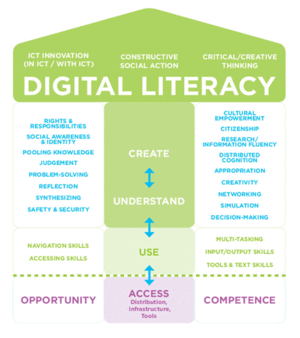Digital Literacy
From DigitalRhetoricCollaborative
| Line 13: | Line 13: | ||
==Use in Education== | ==Use in Education== | ||
| - | Today students are wired to learn digitally and immersed in the digital world with technology always within reach. | + | Today students are wired to learn digitally and immersed in the digital world with technology always within reach. The concept of eLearning has become popular due to the [https://webservices.itcs.umich.edu/mediawiki/DigitalRhetoricCollaborative/index.php/Affordances affordance] of convenience, allowing learning to take place at a time and location that’s better suited to the learner’s needs<ref>Mohammadyari, Soheila, and Harminder Singh. "Understanding The Effect Of E-Learning On Individual Performance: The Role Of Digital Literacy." Computers & Education 82.(2015): 11-25. Academic Search Complete. Web.</ref>. |
==Use in Society/Workplace== | ==Use in Society/Workplace== | ||
Revision as of 17:12, 22 April 2015

Digital literacy is the ability to effectively use digital technology, communication tools or networks across multiple formats and a wide range of sources in order to locate, evaluate, use or create information digitally. This form of literacy further entails that a person has the ability to read and interpret media, to replicate data and images through digital skills, and to evaluate and apply new knowledge and information gained from digital sources[1].
Contents |
History
The concept of digital literacy has evolved in the 21st century from the basic definition of literacy, “traditionally understood as the ability to read and write[2].” In order to be successful in the digital world today, literacy goes beyond the ability to read and write. The evolution of what it means to be digitally literate reflects the change in how information is processed, delivered, and received in the digital age.
Key Components
Development
Use in Education
Today students are wired to learn digitally and immersed in the digital world with technology always within reach. The concept of eLearning has become popular due to the affordance of convenience, allowing learning to take place at a time and location that’s better suited to the learner’s needs[3].
Use in Society/Workplace
Digital literacy is an important topic and skill because technology is developing more rapidly than society is. Because of the unprecedented capabilities and environments that technology provides, appropriate behavior and use in these digital contexts is a work in progress and may be unknowable in certain situations due to a lack of experience. Previously concrete and well-established ideas such as copyright, academic integrity, and privacy are now difficult define or in constant flux[4].
References
- ↑ "Digital Literacy Definition and Resources." University Library of Illinois at Urbana-Champaign. University of Illinois at Urbana-Champaign, 15 Oct. 2008. Web. http://www.library.illinois.edu/diglit/definition.html
- ↑ http://en.wikipedia.org/wiki/Literacy
- ↑ Mohammadyari, Soheila, and Harminder Singh. "Understanding The Effect Of E-Learning On Individual Performance: The Role Of Digital Literacy." Computers & Education 82.(2015): 11-25. Academic Search Complete. Web.
- ↑ "Digital Literacy Resource - Introduction." Cornell University Digital Literacy Resource. Cornell Information Technologies, 1 Jan. 2009. Web. https://digitalliteracy.cornell.edu/welcome/dpl0000.html
External Links
--Samantha Lipkin April 22, 2015
